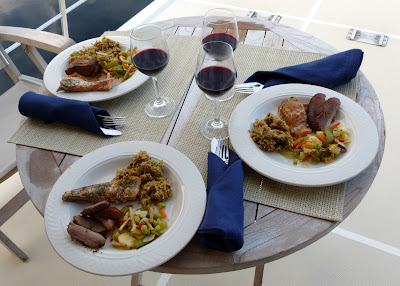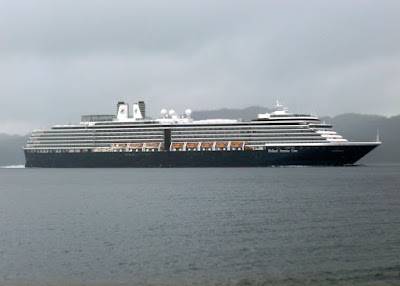Although still gloomy, the rain has stopped. Today we will follow the Maritime to Pruth Bay on Calvert Island. Rob and Donna want to visit the Hakai Institute. The Wild Blue crew wants to use the Institute's open wifi signal to get the email. It's about 5 miles from Lewall Inlet just across the Hakai Passage.
Once there, we hover near the wifi signal and later leave Maritime anchored. We learn from email that our friends on Z-Worthy, another Selene, were behind us in Shearwater two days ago. So today they should be close if they haven't already passed us. We'll keep a lookout for them.
Once out in Fitz Hugh Sound going south, we give the Z-Worthy a call on the VHF. No answer.
We want to end the day in a secure anchorage near Rivers Inlet such that we will be about 4 hours or so from Cape Caution. We need to cross Queen Charlotte Sound which is an exposed ocean run. The nearest anchorage probably is Fury Cove on Penrose Island however it is exposed to southerly winds. We decide upon one of the Frypan anchorages: either Big Frypan or Frypan. The names probably come from their shape. Like Alaska, these anchorages have a handle which is a narrow entrance. The bays are round, much like a frying pan. Frypan is more popular because it is not a deep anchorage.
We arrived at Frypan and anchored as the lone boat then took the tender out exploring local lagoons. Back in the Bay, the Grocery Boy of Anacortes had anchored. This charter boat goes to Alaska each year. We visited on the Grocery Boy and talked about the fishing. THat day Rivers Inlet had yielded them multiple salmon and a huge halibut. The charter crew was quite happy. They will fish again tomorrow. We plan to round Cape Caution.
By 6PM about 7 boats had anchored inside "our" bay. Thirty minutes later we hear "Wild Blue, Wild Blue, this is Z-Worthy" calling on the VHF. Seems they found us via AIS and were heading for Frypan. We invited them to side-tie to Wild Blue and to join us for dinner. Ron and Bonny told scary stories of high winds and nasty seas on their run down northern British Columbia. They seemed too happy to be in a quiet anchorage.
Entering Frypan Bay
Lagoon has it's own ecosystem.
Bill examines this lagoon's flora and fawna.
Wednesday, August 24, 2011: Frypan Bay, Cape Caution to Sullivan Bay
Any Cape Caution rounding starts with the 4AM BC Marine Forecast for Queen Charlotte Sound. Information on the current conditions at the West Sea Otter Buoy and Egg Island Lighthouse is also desirable. Alex monitored the weather broadcast. Our rule of thumb for rounding is: "a Queen Charlotte Sound wind forecast less than 20 knots and a sea condition report at West Sea Otter Buoy less than 1 meter". The seas were already 2 meters at 5AM but the Egg Island Lighthouse reported "Seas rippled with a low northwesterly swell". So at first light, the crew detached Z-Worthy from her side-tie, secured the tender to the boat deck, raised the anchor, and headed south into the Sound. The winds were less than 10 knots but the seas occasionally reached 2 meters (6 feet). Thankfully these larger seas were well-spaced apart so that the rolling motion was mostly dampened by the boats active stabilizer fins.
We took the inside route, just off the coastline, threading our way between the many rocks and reefs that litter the Cape area, but that also provide smoother seas close off the beach. We stayed behind Egg and Table Islands with good sea conditions. Z-Worthy and another yacht followed close behind. By 10AM we rounded Cape Caution as the winds and seas slowly decreased to nothing, and a fog enveloped the boats. We passed a few northbound boats within 1/4 mile without seeing them but the radar and AIS allowed us to pass without collisions. We turned into Wells Passage as the fog lifted and tied to the dock at Sullivan Bay around 2PM in front of Three Wishes another Selene 53. Neil and Nancy invited the crews to a dinner of Greek fair at the floating town's restaurant. The sun came out near the end of the day.
Selenes line the Sullivan Bay Dock: Z-Worthy, Wild Blue, and Three Wishes.
Our first sunset with real sunlight in 5 days!
Thursday, August 25, 2011: Sullivan Bay to Turnbull Cove
Only 40 minutes away, Turnbull Cove is a great place to enjoy the sunshine. Along the way we dropped the prawn traps in 280 feet outside the entrance. Inside the cove we started the crab traps soaking too. Soon after anchoring and side-tying with Z-Worthy, we visited the Nepah Lagoon. The entrance to this 4-mile by 1/2 mile body of water is restricted to 3 feet at low water and is only 50 feet wide so that the current races by at 10 knots, unless you enter at slack. We did so about 30 minutes after slack and the dinghy needed an engine RPM boast. The lagoon is BIG. We motored to the end searching for salmon rivers. Great scenery gave way to the need to exit before the entrance rapids escalated. Upon exit the water fell like a water fall, albeit only a tiny one. We squirted out without incident.
Approaching Turnbull Cove
It's Karen's birthday. No worries, her young age will not be divulged. Tonight's dining venue is on the cleared boat deck of the Wild Blue in brilliant sunshine. The menu is impressive:
Karen's Birthday Epicurean Dinner
Happy Hour: Wiser's Whiskey cocktails with Z-Worthy's fresh sushi
Main Course: Wild White King and Coho Salmon bbq'd on cedar plank, Willie-Bird bbq'd duck breast, wild rice and vegetable medley
Wine: 2004 Opus One
Dessert: Homemade Key Lime pie with fresh-whipped cream.
At last summer has arrived in the Pacific Northwest!
Dining at Wild Blue Skylounge.
Wild Cedar Plank Salmon and BBQ duck breast.
Bonny, Pat and Karen.
Happy Birthday Karen.
Friday, August 26, 2011: Turnbull Cove to Port McNeill
Port McNeill is the destination of choice for exchanging crew. Lately we secure moorage at the Port McNeill Fuel Dock and Marina as opposed to the city run dock. Besides great accommodation and 50-amp power, they provide free use of a van for picking up or dropping off crew at the Port Hardy Airport.
It's a short 3-hour tour of Wells Passage and Queen Charlotte Strait to get to McNeill. The water was flat calm and the Strait displayed little wind. You could see small groups of Dall's Porpoise breaking the surface more than a mile away. As we approached Ledge Point just outside McNeill, many sports-fishers were trolling close ashore. Later we learned that the Coho and Silver Salmon are biting big-time in the early mornings.
On the dock we see the a pretty green Selene 53 named Chatham II. Vera and Len are Canadians who have been cruising BC waters all their lives on sailboats and the last several years on their Selene. They have a cool fireplace inside their saloon. We'll be sure to join them to swap a few sea stories.
Karen and Bill, the Wild Blue crew this past week or so, leave for San Luis Obispo tomorrow. It's been a fun time with the easy going Almas'. Monday a new crew arrives. Pat and Alex will take a few days to wind down.
Evviva arrives in Port McNeill. This 160-foot Westport super-yacht is owned by the guy that built 4000 Bayliner Yachts for years and then sold out to Brunswick Corp. Later he re-entered the boat building business with Westport yachts an "economically priced" super-yacht line. This one sells for an economy minded $30 million. Contrary to the video narrator, we didn't get an invite to dinner aboard Evviva.























































